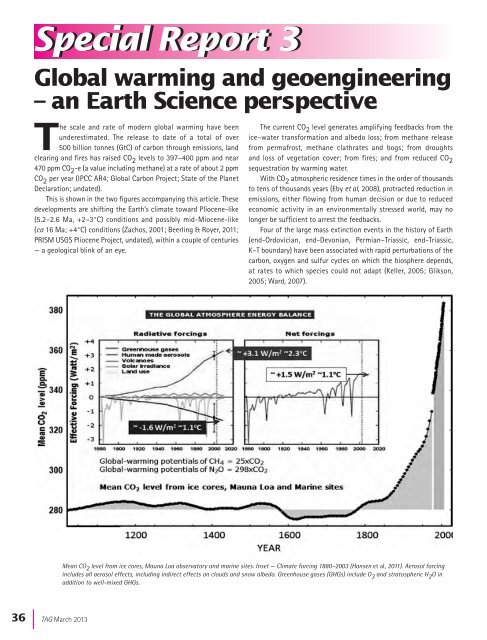TAG 166 - Geological Society of Australia
TAG 166 - Geological Society of Australia
TAG 166 - Geological Society of Australia
You also want an ePaper? Increase the reach of your titles
YUMPU automatically turns print PDFs into web optimized ePapers that Google loves.
Special Report 3Global warming and geoengineering– an Earth Science perspectiveThe scale and rate <strong>of</strong> modern global warming have beenunderestimated. The release to date <strong>of</strong> a total <strong>of</strong> over500 billion tonnes (GtC) <strong>of</strong> carbon through emissions, landclearing and fires has raised CO 2 levels to 397–400 ppm and near470 ppm CO 2 -e (a value including methane) at a rate <strong>of</strong> about 2 ppmCO 2 per year (IPCC AR4; Global Carbon Project; State <strong>of</strong> the PlanetDeclaration; undated).This is shown in the two figures accompanying this article. Thesedevelopments are shifting the Earth’s climate toward Pliocene-like(5.2–2.6 Ma, +2–3°C) conditions and possibly mid-Miocene-like(ca 16 Ma; +4°C) conditions (Zachos, 2001; Beerling & Royer, 2011;PRISM USGS Pliocene Project, undated), within a couple <strong>of</strong> centuries— a geological blink <strong>of</strong> an eye.The current CO 2 level generates amplifying feedbacks from theice–water transformation and albedo loss; from methane releasefrom permafrost, methane clathrates and bogs; from droughtsand loss <strong>of</strong> vegetation cover; from fires; and from reduced CO 2sequestration by warming water.With CO 2 atmospheric residence times in the order <strong>of</strong> thousandsto tens <strong>of</strong> thousands years (Eby et al, 2008), protracted reduction inemissions, either flowing from human decision or due to reducedeconomic activity in an environmentally stressed world, may nolonger be sufficient to arrest the feedbacks.Four <strong>of</strong> the large mass extinction events in the history <strong>of</strong> Earth(end-Ordovician, end-Devonian, Permian–Triassic, end-Triassic,K–T boundary) have been associated with rapid perturbations <strong>of</strong> thecarbon, oxygen and sulfur cycles on which the biosphere depends,at rates to which species could not adapt (Keller, 2005; Glikson,2005; Ward, 2007).Mean CO 2 level from ice cores, Mauna Loa observatory and marine sites. Inset — Climate forcing 1880–2003 (Hansen et al, 2011). Aerosol forcingincludes all aerosol effects, including indirect effects on clouds and snow albedo. Greenhouse gases (GHGs) include O 3 and stratospheric H 2 O inaddition to well-mixed GHGs.36 |<strong>TAG</strong> March 2013
















